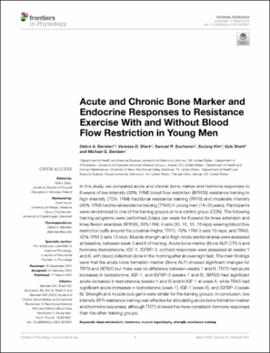| dc.contributor.author | Bemben, Debra A. | |
| dc.contributor.author | Sherk, Vanessa D. | |
| dc.contributor.author | Buchanan, Samuel R. | |
| dc.contributor.author | Kim, SoJung | |
| dc.contributor.author | Sherk, Kyle | |
| dc.contributor.author | Bemben, Michael G. | |
| dc.date.accessioned | 2022-10-17T19:38:32Z | |
| dc.date.available | 2022-10-17T19:38:32Z | |
| dc.date.issued | 2022-03-17 | |
| dc.identifier.citation | Bemben DA, Sherk VD, Buchanan SR, Kim S, Sherk K and Bemben MG (2022) Acute and Chronic Bone Marker and Endocrine Responses to Resistance Exercise With and Without Blood Flow Restriction in Young Men. Front. Physiol. 13:837631. doi: 10.3389/fphys.2022.837631 | en_US |
| dc.identifier.uri | https://hdl.handle.net/11244/336543 | |
| dc.description.abstract | In this study, we compared acute and chronic bone marker and hormone responses to 6 weeks of low intensity (20% 1RM) blood flow restriction (BFR20) resistance training to high intensity (70% 1RM) traditional resistance training (TR70) and moderate intensity (45% 1RM) traditional resistance training (TR45) in young men (18–35 years). Participants were randomized to one of the training groups or to a control group (CON). The following training programs were performed 3 days per week for 6 weeks for knee extension and knee flexion exercises: BFR20, 20%1RM, 4 sets (30, 15, 15, 15 reps) wearing blood flow restriction cuffs around the proximal thighs; TR70, 70% 1RM 3 sets 10 reps; and TR45, 45% 1RM 3 sets 15 reps. Muscle strength and thigh cross-sectional area were assessed at baseline, between week 3 and 6 of training. Acute bone marker (Bone ALP, CTX-I) and hormone (testosterone, IGF-1, IGFBP-3, cortisol) responses were assessed at weeks 1 and 6, with blood collection done in the morning after an overnight fast. The main findings were that the acute bone formation marker (Bone ALP) showed significant changes for TR70 and BFR20 but there was no difference between weeks 1 and 6. TR70 had acute increases in testosterone, IGF-1, and IGFBP-3 (weeks 1 and 6). BFR20 had significant acute increases in testosterone (weeks 1 and 6) and in IGF-1 at week 6, while TR45 had significant acute increases in testosterone (week 1), IGF-1 (week 6), and IGFBP-3 (week 6). Strength and muscle size gains were similar for the training groups. In conclusion, low intensity BFR resistance training was effective for stimulating acute bone formation marker and hormone responses, although TR70 showed the more consistent hormone responses than the other training groups. | en_US |
| dc.description.sponsorship | This study was funded in part by a grant from the International Society for KAATSU Training Research awarded to MB (PI) and DB (Co-PI). Financial support was provided by the University of Oklahoma Libraries’ Open Access Fund. | en_US |
| dc.language | en_US | en_US |
| dc.rights | Attribution 4.0 International | * |
| dc.rights.uri | https://creativecommons.org/licenses/by/4.0/ | * |
| dc.subject | bone metabolism | en_US |
| dc.subject | hormones | en_US |
| dc.subject | muscle hypertrophy | en_US |
| dc.subject | strength | en_US |
| dc.subject | resistance training | en_US |
| dc.title | Acute and Chronic Bone Marker and Endocrine Responses to Resistance Exercise With and Without Blood Flow Restriction in Young Men | en_US |
| dc.type | Article | en_US |
| dc.description.peerreview | Yes | en_US |
| dc.identifier.doi | 10.3389/fphys.2022.837631 | en_US |
| ou.group | Dodge Family College of Arts and Sciences::Department of Health and Exercise Science | en_US |


